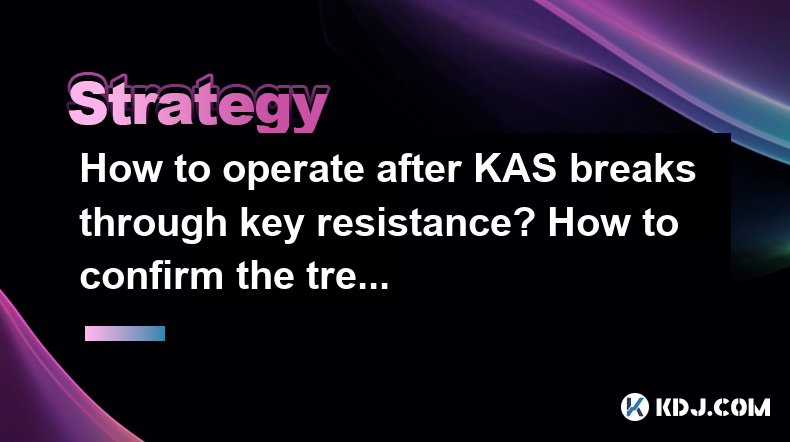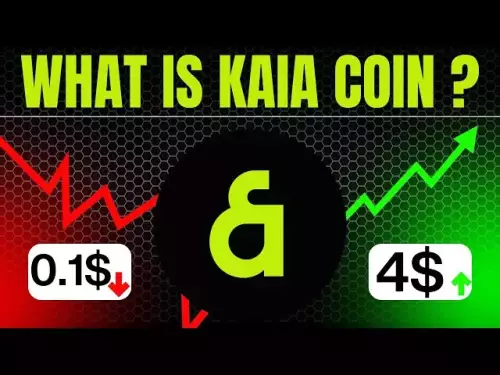-
 bitcoin
bitcoin $112715.707551 USD
-1.71% -
 ethereum
ethereum $4101.475385 USD
-3.01% -
 tether
tether $1.000644 USD
-0.02% -
 bnb
bnb $1207.619465 USD
-6.77% -
 xrp
xrp $2.501451 USD
-3.98% -
 solana
solana $202.947124 USD
-3.32% -
 usd-coin
usd-coin $1.000295 USD
0.04% -
 dogecoin
dogecoin $0.203884 USD
-4.47% -
 tron
tron $0.317154 USD
-1.72% -
 cardano
cardano $0.695009 USD
-4.43% -
 hyperliquid
hyperliquid $38.853961 USD
-8.23% -
 chainlink
chainlink $18.988674 USD
-4.64% -
 ethena-usde
ethena-usde $1.000233 USD
-0.03% -
 stellar
stellar $0.337050 USD
-3.63% -
 bitcoin-cash
bitcoin-cash $536.861728 USD
-1.28%
How to operate after KAS breaks through key resistance? How to confirm the trend continuation signal?
After KAS breaks through resistance, confirm trend continuation by monitoring price action, volume, and using technical indicators like RSI and MACD for reliable signals.
Apr 30, 2025 at 03:14 pm

After KAS breaks through a key resistance level, it's important to understand how to operate effectively and confirm whether the trend will continue. This article will guide you through the steps to take post-breakthrough and how to identify reliable signals for trend continuation.
Understanding Key Resistance Breakthroughs
When a cryptocurrency like KAS breaks through a key resistance level, it indicates potential strength in the asset. A key resistance level is a price point where the asset has historically struggled to move beyond. When the price surpasses this level, it suggests that the market sentiment might be shifting, and buyers are gaining more control.
To confirm that the breakthrough is genuine and not a false breakout, you need to observe certain conditions. The price should close above the resistance level on higher timeframes, such as daily or weekly charts. Additionally, increased trading volume during the breakout can provide further confirmation of the move's legitimacy.
Operating After a Breakthrough
Once you've confirmed a valid breakthrough, your next steps should focus on how to capitalize on the potential upward trend. Here are some strategies to consider:
- Set a New Support Level: After breaking through resistance, the previous resistance level often becomes a new support level. Monitor the price action around this new support to gauge the strength of the trend.
- Use Stop-Loss Orders: To manage risk, set a stop-loss order just below the new support level. This helps protect your investment if the price unexpectedly reverses.
- Take Partial Profits: If you entered a position before the breakthrough, consider taking partial profits to lock in gains while leaving the remainder of your position open to benefit from further upside.
Confirming Trend Continuation Signals
To confirm that the trend will continue after a breakthrough, you need to look for specific signals. Here are some reliable indicators to watch:
- Price Retracement and Bounce: After breaking through resistance, the price may retrace back to the breakout level. If the price bounces off this level and continues upward, it confirms the trend's strength.
- Moving Average Crossovers: Look for the price to stay above key moving averages, such as the 50-day or 200-day moving averages. A bullish crossover, where a shorter-term moving average crosses above a longer-term one, can signal continued upward momentum.
- Bullish Candlestick Patterns: Patterns like the bullish engulfing or hammer can indicate that buyers are still in control. Look for these patterns on higher timeframes for more reliable signals.
Using Technical Indicators for Confirmation
Technical indicators can provide additional confirmation of a trend's continuation. Here are some commonly used indicators and how to interpret them:
- Relative Strength Index (RSI): The RSI measures the speed and change of price movements. If the RSI is above 50 and rising, it indicates bullish momentum. However, be cautious if it enters overbought territory (above 70), as this might signal a potential pullback.
- MACD (Moving Average Convergence Divergence): The MACD helps identify changes in the strength, direction, momentum, and duration of a trend. A bullish MACD crossover, where the MACD line crosses above the signal line, can confirm upward momentum.
- Volume: Increased volume during the breakout and subsequent price increases can confirm the trend's validity. High volume indicates strong interest and participation from market participants.
Practical Steps to Confirm Trend Continuation
Here are detailed steps to follow after KAS breaks through a key resistance level to confirm the trend's continuation:
Monitor Price Action:
- Observe how the price behaves around the new support level. If it holds above this level, it's a positive sign.
- Watch for a retest of the breakout level. A successful retest where the price bounces off the breakout level and continues upward is a strong confirmation signal.
Analyze Technical Indicators:
- Check the RSI: Ensure it's above 50 and not in overbought territory.
- Look at the MACD: Confirm a bullish crossover if it occurs.
- Monitor Volume: Ensure volume remains high during the breakout and subsequent price increases.
Set Up Alerts:
- Use trading platforms to set up price alerts at key levels. This can help you stay informed without constantly monitoring the charts.
- Set alerts for technical indicators like RSI and MACD. These can notify you of potential trend continuation signals.
Review Market Sentiment:
- Read news and analysis related to KAS. Positive news or developments can further support the bullish trend.
- Check social media and forums for sentiment. Bullish sentiment from the community can reinforce the trend's continuation.
Adjust Your Trading Strategy:
- Based on your analysis, decide whether to hold, buy more, or take profits. Adjust your stop-loss orders accordingly to manage risk.
- Consider scaling into your position if you believe the trend will continue. This can help you average your entry price.
Frequently Asked Questions
Q: How long should I wait to confirm a trend continuation after a breakthrough?A: It's advisable to wait for at least a few days to a week after the breakthrough to confirm trend continuation. This allows enough time for price retests, volume analysis, and other indicators to provide reliable signals.
Q: Can false breakouts occur, and how can I identify them?A: Yes, false breakouts can occur. To identify them, look for a quick reversal back below the resistance level, low trading volume during the breakout, and a lack of follow-through in price action. False breakouts often fail to sustain the move above the resistance level.
Q: Should I use multiple timeframes to confirm trend continuation?A: Yes, using multiple timeframes can provide a more comprehensive view of the trend. Confirming signals on higher timeframes, such as daily or weekly charts, can increase the reliability of your analysis.
Q: How important is volume in confirming a trend continuation?A: Volume is crucial in confirming a trend continuation. High volume during and after a breakout indicates strong market interest and can validate the trend's strength. Low volume, on the other hand, might suggest a lack of conviction and could lead to a false breakout.
Disclaimer:info@kdj.com
The information provided is not trading advice. kdj.com does not assume any responsibility for any investments made based on the information provided in this article. Cryptocurrencies are highly volatile and it is highly recommended that you invest with caution after thorough research!
If you believe that the content used on this website infringes your copyright, please contact us immediately (info@kdj.com) and we will delete it promptly.
- XRP Price Prediction: Weekend Rollercoaster or Rally?
- 2025-10-12 08:45:16
- Bittensor (TAO): Super Bullish Signals Point to Potential 2x Rally
- 2025-10-11 10:25:12
- Silver Price Correction: Navigating the Dip & Identifying Key SEO Keywords
- 2025-10-11 10:25:12
- Decoding Crypto Trends: Bittensor's Bull Run, Cardano's Dip, and LivLive's Presale Buzz in 'Uptober 2025'
- 2025-10-12 08:45:16
- MoonBull: The Crypto Meme Coin Promising 1000x Gains?
- 2025-10-11 10:30:01
- Crypto Payroll Revolution: Stablecoins, Altcoins, and the Future of Salary Payments
- 2025-10-11 10:30:01
Related knowledge

Practical parameter settings for a Bitcoin multi-timeframe moving average system
Sep 18,2025 at 10:54pm
Optimizing Timeframe Combinations for Bitcoin Trading1. Selecting appropriate timeframes is crucial when building a multi-timeframe moving average sys...

How can I filter out false breakouts in Dogecoin high-frequency trading?
Sep 22,2025 at 01:00am
Understanding False Breakouts in Dogecoin Trading1. A false breakout occurs when Dogecoin's price appears to move beyond a defined support or resistan...

Techniques for identifying tops and bottoms in the Bitcoin on-chain NVT model
Sep 20,2025 at 07:54pm
Understanding the NVT Model in Bitcoin Analysis1. The Network Value to Transactions (NVT) ratio is often described as the 'P/E ratio' of the cryptocur...

What does the surge in open interest in Bitcoincoin futures mean?
Sep 20,2025 at 11:18pm
Understanding the Surge in Dogecoin Futures Open Interest1. A surge in open interest within Dogecoin futures indicates a growing number of active cont...

How can I use the Ethereum USDT premium to gauge market sentiment?
Sep 18,2025 at 11:55pm
Understanding the Ethereum USDT Premium1. The Ethereum USDT premium refers to the price difference between USDT (Tether) traded on Ethereum-based plat...

What should I do if Ethereum staking yields decline?
Sep 20,2025 at 06:18am
Understanding the Causes Behind Declining Ethereum Staking Yields1. The Ethereum network transitioned to a proof-of-stake consensus mechanism with the...

Practical parameter settings for a Bitcoin multi-timeframe moving average system
Sep 18,2025 at 10:54pm
Optimizing Timeframe Combinations for Bitcoin Trading1. Selecting appropriate timeframes is crucial when building a multi-timeframe moving average sys...

How can I filter out false breakouts in Dogecoin high-frequency trading?
Sep 22,2025 at 01:00am
Understanding False Breakouts in Dogecoin Trading1. A false breakout occurs when Dogecoin's price appears to move beyond a defined support or resistan...

Techniques for identifying tops and bottoms in the Bitcoin on-chain NVT model
Sep 20,2025 at 07:54pm
Understanding the NVT Model in Bitcoin Analysis1. The Network Value to Transactions (NVT) ratio is often described as the 'P/E ratio' of the cryptocur...

What does the surge in open interest in Bitcoincoin futures mean?
Sep 20,2025 at 11:18pm
Understanding the Surge in Dogecoin Futures Open Interest1. A surge in open interest within Dogecoin futures indicates a growing number of active cont...

How can I use the Ethereum USDT premium to gauge market sentiment?
Sep 18,2025 at 11:55pm
Understanding the Ethereum USDT Premium1. The Ethereum USDT premium refers to the price difference between USDT (Tether) traded on Ethereum-based plat...

What should I do if Ethereum staking yields decline?
Sep 20,2025 at 06:18am
Understanding the Causes Behind Declining Ethereum Staking Yields1. The Ethereum network transitioned to a proof-of-stake consensus mechanism with the...
See all articles


























![Staking ATH: How To Stake $ATH in October 2025 with 523% APY — [Step-By-Step Guide] Staking ATH: How To Stake $ATH in October 2025 with 523% APY — [Step-By-Step Guide]](/uploads/2025/10/15/cryptocurrencies-news/videos/staking-ath-stake-ath-october-apy-stepstep-guide/68eef94d80903_image_500_375.webp)















































